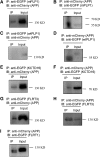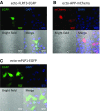Yeast Two-Hybrid Screening for Proteins that Interact with the Extracellular Domain of Amyloid Precursor Protein
- PMID: 26960425
- PMCID: PMC5563743
- DOI: 10.1007/s12264-016-0021-1
Yeast Two-Hybrid Screening for Proteins that Interact with the Extracellular Domain of Amyloid Precursor Protein
Abstract
Alzheimer's disease (AD) is a neurodegenerative disorder in which amyloid β plaques are a pathological characteristic. Little is known about the physiological functions of amyloid β precursor protein (APP). Based on its structure as a type I transmembrane protein, it has been proposed that APP might be a receptor, but so far, no ligand has been reported. In the present study, 9 proteins binding to the extracellular domain of APP were identified using a yeast two-hybrid system. After confirming the interactions in the mammalian system, mutated PLP1, members of the FLRT protein family, and KCTD16 were shown to interact with APP. These proteins have been reported to be involved in Pelizaeus-Merzbacher disease (PMD) and axon guidance. Therefore, our results shed light on the mechanisms of physiological function of APP in AD, PMD, and axon guidance.
Keywords: Alzheimer’s disease; Amyloid precursor protein; Cell death; Pelizaeus-Merzbacher disease; Yeast two-hybrid screening.
Figures




Similar articles
-
Screening of APP interaction proteins by DUALmembrane yeast two-hybrid system.Int J Clin Exp Pathol. 2015 Mar 1;8(3):2802-8. eCollection 2015. Int J Clin Exp Pathol. 2015. PMID: 26045787 Free PMC article.
-
The intracellular domain of amyloid precursor protein interacts with flotillin-1, a lipid raft protein.Biochem Biophys Res Commun. 2006 Mar 31;342(1):266-72. doi: 10.1016/j.bbrc.2006.01.156. Epub 2006 Feb 7. Biochem Biophys Res Commun. 2006. PMID: 16480949
-
Engulfment adapter PTB domain containing 1 interacts with and affects processing of the amyloid-β precursor protein.Neurobiol Aging. 2012 Apr;33(4):732-43. doi: 10.1016/j.neurobiolaging.2010.06.006. Epub 2010 Jul 31. Neurobiol Aging. 2012. PMID: 20674096
-
Impaired autophagy and APP processing in Alzheimer's disease: The potential role of Beclin 1 interactome.Prog Neurobiol. 2013 Jul-Aug;106-107:33-54. doi: 10.1016/j.pneurobio.2013.06.002. Epub 2013 Jul 1. Prog Neurobiol. 2013. PMID: 23827971 Review.
-
Possible roles of amyloid intracellular domain of amyloid precursor protein.BMB Rep. 2010 Oct;43(10):656-63. doi: 10.5483/BMBRep.2010.43.10.656. BMB Rep. 2010. PMID: 21034527 Review.
Cited by
-
Amyloid precursor protein (APP) and amyloid β (Aβ) interact with cell adhesion molecules: Implications in Alzheimer's disease and normal physiology.Front Cell Dev Biol. 2022 Jul 26;10:969547. doi: 10.3389/fcell.2022.969547. eCollection 2022. Front Cell Dev Biol. 2022. PMID: 35959488 Free PMC article. Review.
-
The Mitochondrion: A Potential Therapeutic Target for Alzheimer's Disease.Neurosci Bull. 2018 Dec;34(6):1127-1130. doi: 10.1007/s12264-018-0310-y. Epub 2018 Nov 12. Neurosci Bull. 2018. PMID: 30417261 Free PMC article. Review. No abstract available.
-
Alzheimer's Disease: Significant Benefit from the Yeast-Based Models.Int J Mol Sci. 2023 Jun 6;24(12):9791. doi: 10.3390/ijms24129791. Int J Mol Sci. 2023. PMID: 37372938 Free PMC article. Review.
References
Publication types
MeSH terms
Substances
LinkOut - more resources
Full Text Sources
Other Literature Sources
Molecular Biology Databases

